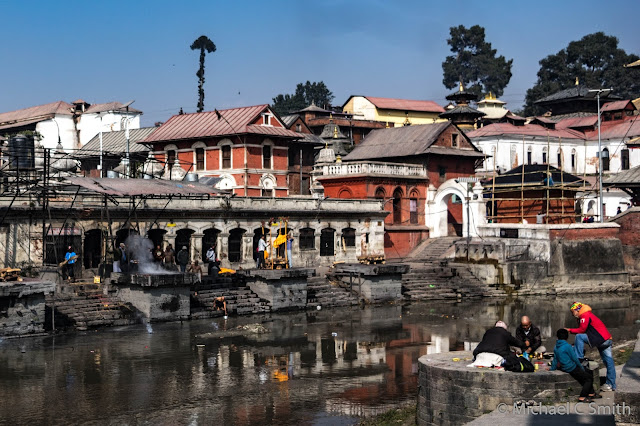The Legend of Swayambhunath - Legend says that once the Kathmandu valley was a lake in which Swayambhunath hill existed as an island. On top of that hill stood a natural crystal stupa. Buddha, when visiting the place, declared that it was a wish-fulfilling stupa and whoever is touched by the wind that passes over the stupa receives the seed of liberation from the cycle of existence.
Saturday, 10 December 2016
Boudhanath - Kathmandu
There is nowhere quite like Boudhanath. Asia’s largest stupa pulses with life as thousands of pilgrims gather daily to make a kora (ritual circumnavigation) of the dome, beneath the watchful eyes of the Buddha, which gaze out from the gilded central tower. Tibetan monks in maroon robes and with shaved heads wander the prayer flag–decked streets while pilgrims spin prayer wheels and stock up on yak butter and tsampa (roasted barley flour). This is one of the few places in the world where Tibetan Buddhist culture is accessible and unfettered, and the lanes around the stupa are crammed with monasteries and workshops producing butter lamps, ceremonial horns, Tibetan drums, monks’ headgear and the other paraphernalia essential for Tibetan Buddhist life. The stupa shook ominously in the 2015 earthquake, but only sustained some minor damage; it has now been fully restored.
Pashupatinath Temple - Kathmandu
One of the most sacred Hindu temples of Nepal - Pashupatinath Temple is located on both banks of Bagmati River on the eastern outskirts of Kathmandu. Pashupatinath is the most important temple dedicated to god Shiva. Every year this temple attracts hundreds of elderly followers of Hinduism. They arrive here to find shelter for the last several weeks of their lives, to meet death, be cremated on the banks of the river and travel their last journey with the waters of the sacred river Bagmati, which later meets the holy river Ganges. Hinduists from every corner of Nepal and India are arriving here to die. It is believed that those who die in Pashupatinath Temple are reborn as a human, regardless of any misconduct that could worsen their karma.
Friday, 9 December 2016
Day 8 Lobuje - Gorak Shep and Everest Base Camp, Everest Base Camp Trek 2016
Sun 20th Dec - Lobuje (4,930m) - Gorak Shep (5,184m) - Everest Base Camp (5,380m)
A very long, hard day where we follow the Khumbu Glacier northwards to Gorak Shep (5,184m). The trail undulates up and down the moraine with some steep sections. The trail is rocky in places as we are now on the lateral moraine of the Khumbu Glacier. It takes us 3 hours to reach Gorak Shep. After a rest we walk across the sandy flat at Gorak Shep and climb onto the lateral moraine of the Khumbu Glacier. The trail ascends the side of the glacier for a couple of hours before finally descending onto the rocky glacier moraine itself. The trail winds up and down through fascinating ice seracs to the area known as Everest Base Camp. After a short stop we retraced our steps to Gorak Shep.
A very long, hard day where we follow the Khumbu Glacier northwards to Gorak Shep (5,184m). The trail undulates up and down the moraine with some steep sections. The trail is rocky in places as we are now on the lateral moraine of the Khumbu Glacier. It takes us 3 hours to reach Gorak Shep. After a rest we walk across the sandy flat at Gorak Shep and climb onto the lateral moraine of the Khumbu Glacier. The trail ascends the side of the glacier for a couple of hours before finally descending onto the rocky glacier moraine itself. The trail winds up and down through fascinating ice seracs to the area known as Everest Base Camp. After a short stop we retraced our steps to Gorak Shep.
Day 7 Dingboche - Lobuje, Everest Base Camp Trek 2016
Sat 19th Dec - Dingboche (4,350m) - Lobuje (4,930m)
The trail climbs steeply out of Dingboche past a chorten and ascends the valley gradually to Dugla at the end of the terminal moraine of the Khumbu Glacier. From here we have a short, steep climb up to Chukpo Lari, a beautiful, yet poignant place where there is a line of memorials in tribute to the climbers who have died on Everest. The trail then eases off as we follow the valley to Lobuje, a tiny hamlet with a few teahouses.
The trail climbs steeply out of Dingboche past a chorten and ascends the valley gradually to Dugla at the end of the terminal moraine of the Khumbu Glacier. From here we have a short, steep climb up to Chukpo Lari, a beautiful, yet poignant place where there is a line of memorials in tribute to the climbers who have died on Everest. The trail then eases off as we follow the valley to Lobuje, a tiny hamlet with a few teahouses.
Subscribe to:
Comments (Atom)



























































